|
FC3S Pro: Zenki FC3S Throttle Body Mod |
|---|
 |
Entrance of stock throttle body
Looking through the throttle body, you'll see 3 bores. The primary
bore is on top. The secondary bores are at the bottom. In the
pair of secondary bores, there are two sets of throttle plates; we will
remove one set of these throttle plates.
Make sure you're looking through the front of the throttle body. One
pair of secondary throttle plates should be closer to you when looking
down into the bores of the throttle body; the primary throttle plates
should be deeper in it's bore. If the primary and secondary throttle
plates are the same distance in the bores, flip the throttle body
over. The pair of throttle plates in the secondary bores that are
closer to you are the ones we remove.
Shown is the throttle body with the secondary throttle plates we want to
remove in front. The RED arrows point
to the plates we want to remove. The
YELLOW arrows points to the main set of
secondary throttle plates that will remain. |
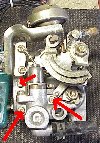 |
Back view of throttle body
Three screws (RED arrows) need to be removed
to loosen the cold-start thermowax sub-assembly. The cold-start thermowax
sub-assembly might be stuck due to a gasket. Prying with a flat-head
screwdriver on the cold-start thermowax sub-assembly should free it for
removal. |
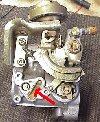 |
Cold-start thermowax assembly removed
Notice coolant passage (RED arrows) is revealed
when cold-start thermowax sub-assembly is removed. Also revealed is the
shaft (BLUE arrow) of double throttle plates
that needs to be removed. |
 |
Rear of the throttle body after cold-start thermowax
sub-assembly removed
RED arrow points to screw that holds the springs
arm and fast-idle cam pivot points. Be careful when unscrewing this screw
with the screwdriver; the screw head is soft and easily damaged - it has been
known to be seized. Also, be careful when removing the screw and spring
arm as it holds two springs
(YELLOW arrows) in place. Carefully note
the position of the springs on the spring arm, or you will lose track of the
positions of the springs in their grooves. |
 |
Closer shot of the fast-idle cam
RED arrow points to screw that needs to
be removed. YELLOW arrow points to the
edge of the fast-idle cam that would normally rest on the lower post
(green paint) on cold-start - this is what causes the higher idle on
cold-start. Those who are lazy and do not remove this fast-idle cam run
into high idle problems (2,000RPM to 3,000RPM) due to the fast-idle cam
jamming here! The fast-idle cam jams on the lower post (green paint)
when not removed properly. |
 |
Screw that holds spring stop and fast-idle cam pivot is
removed
The spring stop has been moved just slight out of the way (upward).
Notice spring stop is keyed. The fast-idle cam and associated spring
are still intact with a circular clip.
RED arrow points to the small circular clip
that needs to be removed. Once this circular clip is removed, the
fast-idle cam and spring can be removed. |
 |
Small circular clip, fast-idle cam, and spring removed
Fast-idle cam and spring removed from the throttle body. It's tricky
removing these, but a little wiggling helps in removal. Be careful with
the spring stop and try to keep the spring ends from jumping off their
respective grooves. |
 |
Cold-start thermowax sub-assembly and fast-idle
cam (and spring) removed
The spring stop and screw has been already replaced back into their original
positions. A lot cleaner back there! |
 |
Entrance of throttle body
Moving to the front of the throttle body, we need to remove the screws
that hold the throttle plates in. The
RED arrows show the positions of the
four screws that have already been removed.
Make sure you're removing screws from the
correct set of throttle plates!
The primary throttle plate should be deep inside it's primary bore.
If the primary throttle plate is the same depth of the secondary throttle
plates, flip the throttle body over! The throttle plate screws are
on tight (thread locker?) and the screw heads are soft. Use liberal
amounts of your favorite penatrant (i.e. Liquid Wrench, WD-40, P'Blaster)
to aid in removal. An impact driver can be used, but be careful with
the soft screw heads. You can always drill the screws out if you
manage to damage them. We will not be reusing these parts, you do
not have to be careful about keeping them good shape. Be careful about
slipping and damaging the rest of the throttle body! |
 |
Throttle plates screws and throttle plates removed from
shaft
To aid removal of the throttle plates, carefully angle plates toward you
and wiggle gently them free. |
 |
Throttle plates removed from throttle body |
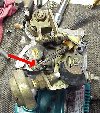 |
Front of throttle body
Turn the throttle body over to the front.
RED arrow points to a small cotter pin that needs
to be removed. We are trying to remove the long arm with that spring
on it. Note, TPS has been removed. |
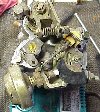 |
Cotter pin and washer removed
The arm should be loose now. Remove this entire assembly that
holds the shaft that used to hold the removed throttle plates.
The assembly should slide right out of the throttle body. Note,
TPS has been removed. |
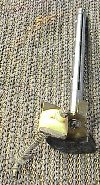 |
Throttle plates shaft/arm assembly removed
This is the entire assembly after it has been removed from the throttle body.
|
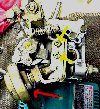 |
Removal of unnecessary front dashpot
RED arrow points to front dashpot.
YELLOW arrows point to two screw that
secure the bracket that holds the dashpot. Note, TPS has been
removed. |
 |
Front dashpot removed
Front dashpot removed, including the two screws. |
 |
Front of throttle body with all unnecessary parts removed
With the throttle shaft assembly and front dashpot removed, the front of the
throttle body is cleaner. RED arrow points
to the hole left in the front of the throttle body due to the removal of the
throttle shaft - this hole needs to be plugged. You can either tap/plug
or seal the hole with epoxy (i.e. J.B. Weld). If using epoxy, tape the
holes from the inside and pour the epoxy and let set. |
 |
Installing the ⅛"-27 NPT plug
A ⅛""-27 NPT tap is used to thread the holes to accept a ⅛""NPT plug.
This pic shows the front hole being tapped. These shaft holes barely hold
the ⅛""NPT tap. The proper method to use a tap is to make sure the tap
goes all the way down until you see no threads on the tap. The plug
should end up sitting very far down in the tapped hole. We are actually
tapping a bronze bushing, but you can punch this bushing out and use a larger
tap and plug. |
 |
The NPT plug
We're using Aeroquip ⅛" "PIPE PLUG HEX SOCKET". These fit very snuggly for
this modification. You can try ⅛""-27 NPT plugs from from your local hardware
store. Big chains like Home Depot, Lowes, etc. have cheap steel or brass plugs
that should work. |
 |
Aeroquip ⅛"-27 NPT plug fitted in tapped hole
We recommend using PST (Pipe sealant with Teflon) or any liquid thread sealant.
You can also use threadlocker (i.e. Loctite red or blue). |
 |
Tapping rear shaft hole
Rear shaft hole being tapped with ⅛"-27NPT tap. Again, note the bronze
bushing. Make sure the tap goes all the way down. The ⅛""NPT plug
should sit flush with the inside walls. Don't forget the thread sealant! |
 |
Rear shaft hole plugged with Aeroquip ⅛"NPT plug
This concludes the modification to the throttle body itself. You'll
need to reroute the 90� coolant hose that used to connect the rear end
side housing to the throttle body for the cold-start system (now
removed). You can either run a hose from the engine to the BAC
valve, or you can run a hose from the rear engine housing to the back of
the water pump housing which will bypass the stock BAC valve.
NOTE: Because of the very limited amount of space under the throttle
body, you need to run a pre-formed, 90� hose. Most local auto parts
stores carry preformed 5/16" hose with 90� bends. I found a hose
designed for a Mopar that has a short 4" leg on one end (needs to be
shortened to fit the nipple on the engine block) and a 18" length leg that
can be run to the BAC valve.
|





